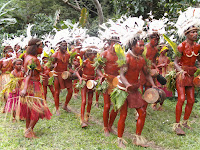
Clara Kuangan epitomises what Grasrut Univesiti of Life is all about.
Affectionately known to all as Mama Clara, this grey-haired elderly mother from Maprik in East Sepik Province was one of the first people to attend a Personal Viability (PV) course some years ago. PV is part of the Grasrut Univesiti of Life education philosophy that has been in taught in PNG for six years now. She says the course has changed her whole life.
Last month she was among more than 60 people from different parts of PNG who paid their way to Madang to attend a symposium at Divine Word University. They talked about how the PV course had helped them. They said it had empowered them to become more productive, to use their brains and hands and the abundant resources around them to help themselves. And they displayed the range of products that they have made or have been using to help themselves prosper financially.
When Mama Clara was asked to speak, she had a message for PNG.
“Do not sit around and beg for handouts. Use your God-given brains, hands, talents and the resources around you to earn a living! It is possible,” she said.
It was heartening to hear this elderly mother speak so positively at a time when PNG is experiencing yet another economic crisis forcing prices of goods to climb, the value of the kina to plunge and worsening law and order problems.
Mama Clara’s message is not new. It has been the favourite topic of politicians and government officials at most ceremonies. Most of them however would have no idea what it means to work for themselves.
Mama Clara lives at Nuigo squatter settlement in Wewak. She turned up at DWU with a range of products she had made that included home-made peanut butter, jewelry, hand bags, hats as well as her prized possession – a hand-made mountain bag. The bag was woven from local fibres abundant in the forests and normally used for making bags and bilums. Mama Clara had little formal education and her industrious skills certainly did not come from any formal training. It all began after she attended the personal viability course run by its founder Samuel Tam in Wewak some years ago. The course opened a door of opportunities she was not aware of previously. It showed her that she could use her traditional bilum-making skills to create other profitable products. Inspired, she tried weaving a ladies hand-bag from the local fibres. It was an instant success. She said suddenly the women in Wewak crowded her home wanting to learn the new skill. She never looked back since.
Helen Paru is another Madang mother who has a flourishing business growing and selling fruit trees and flowers in her backyard. She said she did not realise the opportunities until she attended a PV course in Madang.
There is nothing magical about personal viability. It is basically an integral human development course that is fulfilling the national goals and directive principles in PNG’s National Constitution. The Constitution calls for integral human development, equality and participation, national sovereignty and self-reliance, conservation of natural resources and environment and using Papua New Guinean ways to achieve development.
An official PV leaflet says the course trains people to evaluate and enhance their personal viability. Put simply it makes people aware of their abilities to think and do things especially to help themselves by using the resources around them. It is also a holistic development course which helps people understand their emotions, their physical health, their mental and spiritual selves, as well as to show them how to prosper financially. It helps people to believe in themselves and how to relate to others and to recognise the value of the resources around them and use them to enhance their lives.
While PV is not formally recognised by the PNG Government, it is being welcomed by many organisations as an answer to helping their people. The biggest organisation so far is the United Church of PNG whose Moderator, Rev. Samson Lowa, has directed his bishops to attend PV training and to ensure that its 600,000 strong members must all undergo the course in their congregations.
Lutheran and Catholic churches, NGO groups and major resource developers such as Ok Tedi have also endorsed personal viability training for the people.
There are reasons for the growing attraction to the PV course and the Grasrut Yunivesiti of Life philosophy.
The country’s recurring cycles of economic woes since the early 90s have been worrying many Papua New Guineans. It seems the nation’s successive governments have been unable to control rising poverty levels, unemployment and law and order problems. People are now questioning whether the governments are capable of solving these problems. They are also concerned that the education system is educating people for jobs that are becoming increasingly rare. Instead they are advocating a system that should educate people for life.
For those Papua New Guineans who have come into contact with PV, it has filled a void in their lives. It has developed their confidence and made them believe in themselves. It has shown them that one can succeed despite the social, economic and political problems that face the country.
The course is the brain-child of businessman, Samuel Tam, and is run by group of dedicated volunteers using their own time and resources. Mr Tam, affectionately called Papa Sam by his students, is the person who established the Stret Pasin Stoa Scheme – the most successful small business scheme which has enabled many Papua New Guineans to successfully own and run trade stores. This scheme has been studied and adopted by other Pacific island nations.
Mr Tam urged Papua New Guineans to use their ‘neck-top computers’ that is their brains. He said the brain is 100 million times more powerful than any computer. “Take control of your own destiny. Own yourself. Think and act, do it yourself. Don’t ever let outsiders decide for you.”













